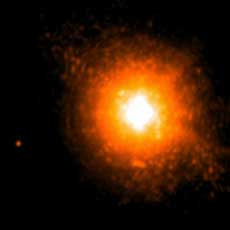
A deep image of the Gliese 86 system taken at the Very Large Telescope in Chile reveals a faint white dwarf (left) about 21 astronomical units from the overexposed primary star (right). A planet orbits the primary, which proves that planets can survive a nearby star's evolution through the red-giant and planetary-nebula phases.
Courtesy Markus Mugrauer, Ralph Neuhäuser, and ESO.
Can planets survive the evolution of a star through the red-giant and planetary-nebula phases? Recent observations by Markus Mugrauer and Ralph Neuhäuser (University of Jena, Germany) show that the answer is a resounding "yes."
The story begins in 2000, when Didier Queloz (Geneva Observatory, Switzerland) and his colleagues, using the radial-velocity (wobble) method, discovered a planet orbiting the 0.7-solar-mass K1 dwarf star Gliese 86 in Eridanus. The planet has at least 4 Jupiter masses and orbits at a distance of 0.11 astronomical unit (1 a.u. is the average Earth-Sun distance). But Queloz's group also noticed from the data that another massive body orbits the star at a much greater distance than the planet. A year later, Sebastian G. Els (Thüringer observatory, Germany) and five colleagues used a 3.6-meter telescope in Chile to image this companion (Gliese 86B), which they interpreted as a brown dwarf orbiting the primary star (now called Gliese 86A) at a distance of about 20 a.u. But a brown dwarf is not massive enough to explain the more distant object.
On January 12th, Mugrauer and Neuhäuser targeted the Gliese 86 system with Yepun, one of the four 8.2-meter reflectors comprising the European Southern Observatory's Very Large Telescope in Chile. They used an adaptive-optics instrument on Yepun to counter atmospheric turbulence. Their near-infrared spectroscopy of Gliese 86B yields a temperature estimate of 4,700 degrees Celsius (8,500 degrees Fahrenheit), which is much too hot for a brown dwarf. Given Gliese 86B's temperature and low luminosity, the object is almost certainly an old, relatively cool white dwarf. Such a body is easily massive enough to explain the more distant object. Mugrauer and Neuhäuser also confirmed that Gliese 86B is separated from Gliese 86A by a distance of about 21 a.u., but their images have found no additional companions.
The white dwarf is the dead core of a star that expanded into a red giant and later blew off much of its outer envelope to form a planetary nebula. "Gliese 86 is the first observational evidence that planets indeed can survive the planetary-nebula stage of a star located only 20 a.u. away, that is, the Uranus-Sun distance," says Mugrauer, whose paper appears in the July Monthly Notices of the Royal Astronomical Society. This is in accordance with theoretical predictions.
The planet escaped death once, but it won't survive a second round of stellar evolution. When the K1 dwarf begins expanding into a red giant at the end of its main-sequence lifetime, the planet will plow through the star's outer atmosphere and suffer orbital decay, eventually meeting a fiery demise in the hellfires of the stellar furnace.
"The result is certainly significant in the context of looking for planets around white dwarfs, and it provides interesting issues for the formation of planets as well," says John H. Debes (Pennsylvania State University), who is leading a team that is using the Hubble Space Telescope to search for planets around white dwarfs. Debes hopes Mugrauer and Neuhäuser will follow-up with visible spectra to detect the telltale spectral signatures of a white dwarf, which Mugrauer says his team plans to do.
 0
0
Comments
You must be logged in to post a comment.